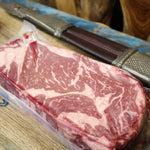
Chapter 7: The Industrialization of Beef
This chapter immerses us in the transformative era where the traditional methods of raising and processing beef underwent profound changes with the advent of industrialization. From feedlots and processing plants to innovations in packaging and distribution, we explore how beef became a commodity produced on an unprecedented scale.
The Rise of Feedlots: Changing the Landscape of Cattle Rearing (Late 19th Century)
As industrialization swept through the beef industry in the late 19th century, the traditional image of cattle grazing on open pastures began to shift. Feedlots emerged as a dominant feature of beef production, where cattle were brought together for efficient feeding and accelerated growth. The concentration of large numbers of cattle in feedlots became a hallmark of industrialized beef production, reshaping the dynamics of cattle rearing. It marked a shift in the economic model, with a focus on maximizing efficiency and output, laying the foundation for modern feedlot operations.
Technological Advances in Processing: From Butcher Shops to Assembly Lines
Industrialization brought about significant advancements in meat processing, with the traditional butcher shop giving way to large-scale assembly lines. Innovations such as the disassembly line, where each worker had a specific task in processing beef, increased efficiency and lowered costs. The adoption of mechanized processing equipment transformed the industry, allowing for higher production volumes and standardization of cuts.
While these technological advances streamlined the production process, they also raised concerns about worker conditions. The shift from artisanal butchery to industrial processing marked a pivotal moment in the history of beef consumption.
Packaging and Distribution: Bringing Beef to Every Corner (Mid-20th Century)
Industrialization revolutionized how beef was packaged and distributed. Vacuum packaging, introduced in the mid-20th century, extended the shelf life of beef and facilitated long-distance transportation. This innovation allowed for the widespread availability of beef in supermarkets and grocery stores, making it a staple in households across the globe.
As beef became more accessible, the consumer landscape transformed. Marketing and branding became integral to the beef industry, with labels and packaging designed to appeal to a broader audience. The chapter explores the cultural shifts in consumer behavior and the impact of these changes on the beef industry's economic landscape.
Globalization of the Beef Industry: Challenges and Opportunities
The industrialization of beef production also led to the globalization of the industry. Beef from various parts of the world began to find its way onto the plates of consumers globally. This interconnectedness presented both opportunities and challenges. Consumers gained access to a diverse range of beef products, but concerns about ethical sourcing, sustainability, and the impact on local economies arose.
The chapter delves into the complexities of an industry undergoing rapid change, exploring the consequences, both positive and negative, of the industrialization of beef production and its globalization. It discusses the opportunities for cultural exchange through food and the challenges posed by the standardization of tastes and production methods.
As we follow beef from pasture to plate, we witness how the industrialization era, marked by the rise of feedlots in the late 19th century, shaped not only the way we consume beef but also the broader ethical, economic, and cultural considerations that accompany it.



